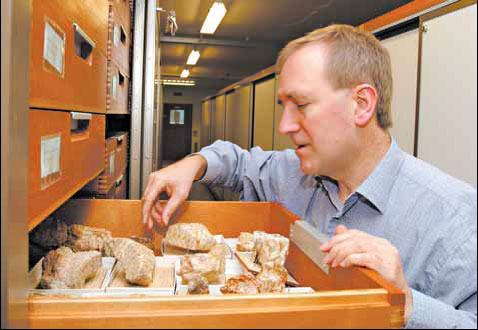Tracing the complicated trail of human origins
Updated: 2012-07-29 07:13
By John Noble Wilford(The New York Times)
|
|||||||
|
Chris Stringer, a British paleoanth- ropologist, is the author of "Lone Survivors: How We Came to Be the Only Humans on Earth." Natural History Museum London |
For scientists studying the origin of modern humans, Homo sapiens, research is advancing on three fronts. Fossils of bones expose anatomical changes. Genetics reveals the timing and place of the Eve of modern humans.
And archaeology turns up ancient artifacts reflecting abstract and creative thought, and a growing self-awareness.
The British paleoanthropologist Chris Stringer is a leading authority on modern human evolution. Dr. Stringer, 64, is an anthropologist at the Natural History Museum in London and a fellow of the Royal Society.
A condensed and edited version of our conversation follows.
Q.You wrote that in 1970, the origin of modern humans was hardly recognized as a topic worthy of study. What has changed?
A.In 1970, for some people, there was no single origin: we evolved all over the world. There was a view that in the different regions an earlier species, Homo erectus, evolved to modern humans. This was known as multiregionalism.
The argument went that we remained one species because there was interbreeding among the different populations. The Neanderthals in Europe would be the ancestors of modern Europeans; Homo erectus in China would be the ancestor of modern Asians. And Java Man would be a distant ancestor of modern Australian aboriginal populations.
DNA studies have had a huge impact.
Q.What about the African Eve? This established an approximate date for the genetic origin of modern humans, in Africa.
A.The Mitochondrial Eve publication of 1987 was a key moment. Here was an independent bit of data, from our mitochondrial DNA, suggesting we originated from a single population in Africa maybe 200,000 years ago. Africa was the only place that showed a transition from archaic to modern humans.
Q.You propose that there was not one place in Africa where modern humans originated.
A.The DNA data show that essentially each of our genes has a separate evolutionary history. And so there is no single spot in Africa that seems to be the place for our origins genetically.
Africa is a huge place influenced by the Mediterranean, the North Atlantic, the South Atlantic, the Southern Ocean, the monsoons coming off the Indian Ocean. Populations in different areas would have flourished briefly, developed new ideas, and then maybe died out - this was being controlled by the climate - but not before exchanging genes, tools and behavioral strategies.
This kept happening, and finally we start to see the modern pattern behaviorally and physically coalescing from these different regions to become modern humans by about 60,000 years ago.
Q.Cave art of Europe influenced the view that modern behavior began there 40,000 years ago. How firm is the new view?
A.I would argue when modern humans came out of Africa, say 60,000 years ago, fundamentally they were behaviorally modern.
Q.Do you accept the new evidence of Neanderthal-Homo sapiens interbreeding?
A.This is one of the remarkable bits of news of the last couple of years. We've had the genomes of Neanderthals reconstructed, and yes, it shows that people outside of Africa have, on average, about 2.5 percent of Neanderthal DNA in them; clearly there was viable interbreeding.
Q.Who were the Denisovans?
A.It's an extraordinary discovery. A few teeth, a finger bone have produced a genome that's posted on the Web site of the Max Planck Institute for Evolutionary Biology in Leipzig, Germany. It seems Denisovans were an early branch off the Neanderthal line.
They are only known from one site in Siberia, and their DNA turns up in people today - down in Australia and New Guinea. That's extraordinary. This implies the Denisovans must have been a widespread group.
Q.Could we ever clone these extinct people?
A.Theoretically, you could cut and paste those Denisovan mutations into a modern human genome, and then implant that into an egg and grow a Denisovan.
I think it would be completely unethical. Bringing isolated individuals back, for our own curiosity or arrogant purposes, would be completely wrong.
Q.What is the future of human evolution?
A.Geneticists have showed just how many genetic changes there have been in the last few thousand years, because we've undergone great changes with urbanization, agriculture, very big changes in lifestyles. And this has influenced our genetic makeup. Selection is still operating. All of us probably have 50 mutations in our DNA compared with our parents. So we are still evolving. We will continue to evolve.
The New York Times
(China Daily 07/29/2012 page11)
